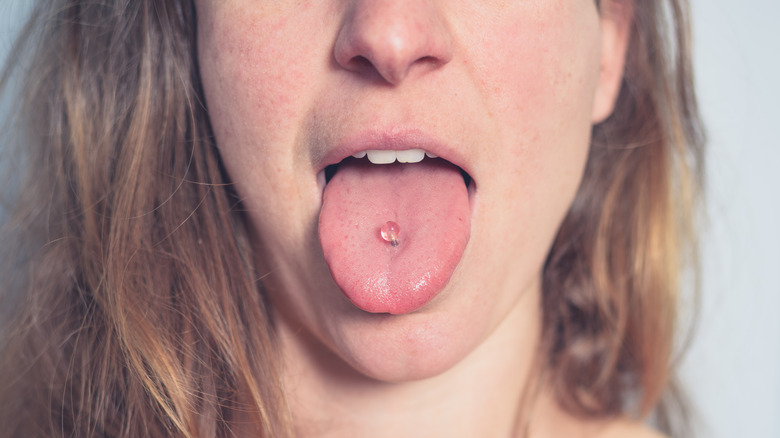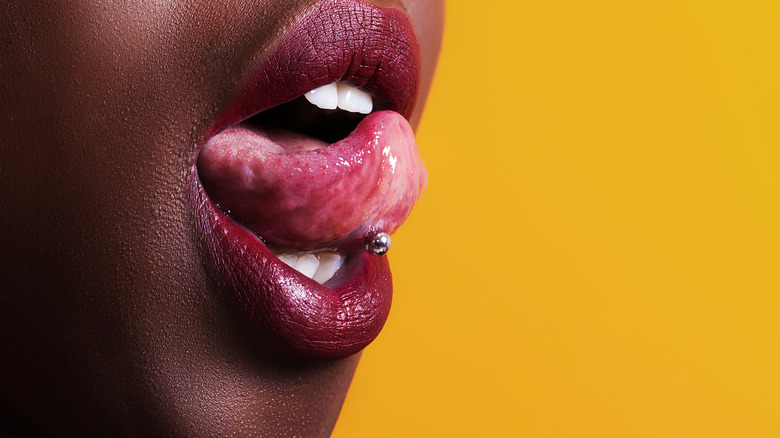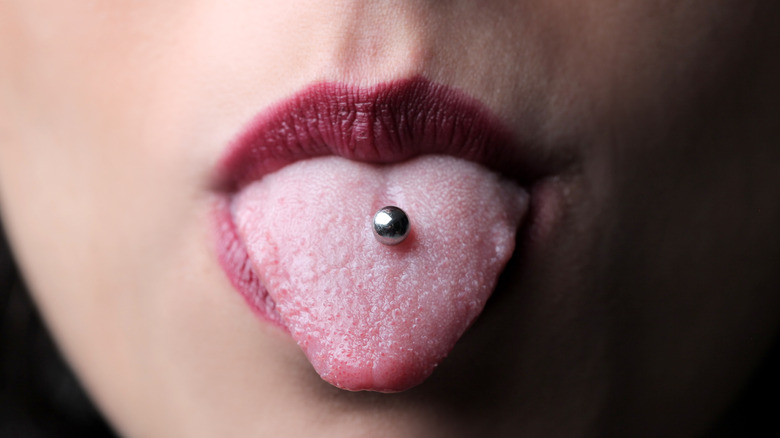How To Make A Tongue Piercing Less Painful

Lolostock/Shutterstock
By Sophie McEvoy/Aug. 30, 2021 12:42 pm EDT
Out of all the body modifications you can get, a tongue piercing can often be the most intimidating. Unlike your typical ear or nose piercing, this modification perforates one of your body’s most used muscles. The tongue is actually made up of two muscles (via Sacrament Body Piercing), as well as tissue known as the mucosa, tiny bumps called papillae, and thousands of taste buds which also contain “nerve-like cells” that send information to your brain.
The tongue is a pretty complicated organ, and therefore can be one of the more painful piercings to have — thanks to it being a thick muscle layered with elaborately delicate pathways of tissue (via Annual Review of Physiology). But when done by a professional piercer, it can be a lightning-fast process that doesn’t hurt as much as you think it would.
As with any piercing, there’s always the possibility that your body will reject it, per professional piercer Lynn Loheide. But by maintaining a strict after-care regime can mitigate that risk and lead to less pain after the initial piercing.
A strict after-care regime is vital to keep pain at bay with a tongue piercing

Prior to what happens after the piercing, it’s recommended that you clean your teeth, mouth, and gums throughly before your appointment. Love to Know suggests also giving your teeth a good floss, and well as swishing some antiseptic mouthwash around to get rid of all the germs that could potentially cause a painful infection (and possible rejection). This mouth cleaning routine will be an integral part of the after-care routine too, in order to keep the piercing healthy and to prevent infection.
Wherever you get pierced, it will be sore and painful following the initial piercing. But it’s a little different with the tongue, as it can interrupt the way you usually eat or drink. Love to Know recommends eating soft foods for the first two days to prevent pain, as well as frequently rising your mouth out with a salt rinse. This can also be used throughout the day to mitigate pain or swelling (via Healthline). Hot drinks are also to be avoided in the first week or so of having the piercing, as it can cause further swelling.
A tongue piercing can take between six to eight weeks to heal

There are plenty more simple solutions when it comes to making your tongue piercing less painful. Sucking on ice cubes can be a major relief, or even just drinking ice cold water (via leaf.tv). If that’s not making the pain budge, acetaminophen or paracetamol may help relieve discomfort and also keep swelling at bay. It’s recommended not to use any pain relieving medicine that includes Aspirin, as it can make you bleed more.
Another thing to avoid is any alcohol-based mouthwash. Despite rinsing your mouth with an antiseptic mouthwash prior to the piercing, Painful Pleasures recommends avoiding these sorts of products as the alcohol will make the cleaning experience even more painful. It can also dry out the piercing, and make the healing process longer.
As Healthline notes, it can take up to eight weeks for a tongue piercing to completely heal. This is when you can be a little less stringent on the after-care routine, but keep an eye on what irritates your piercing as this can lead to pain and possible infection down the line.
Source: Read Full Article
